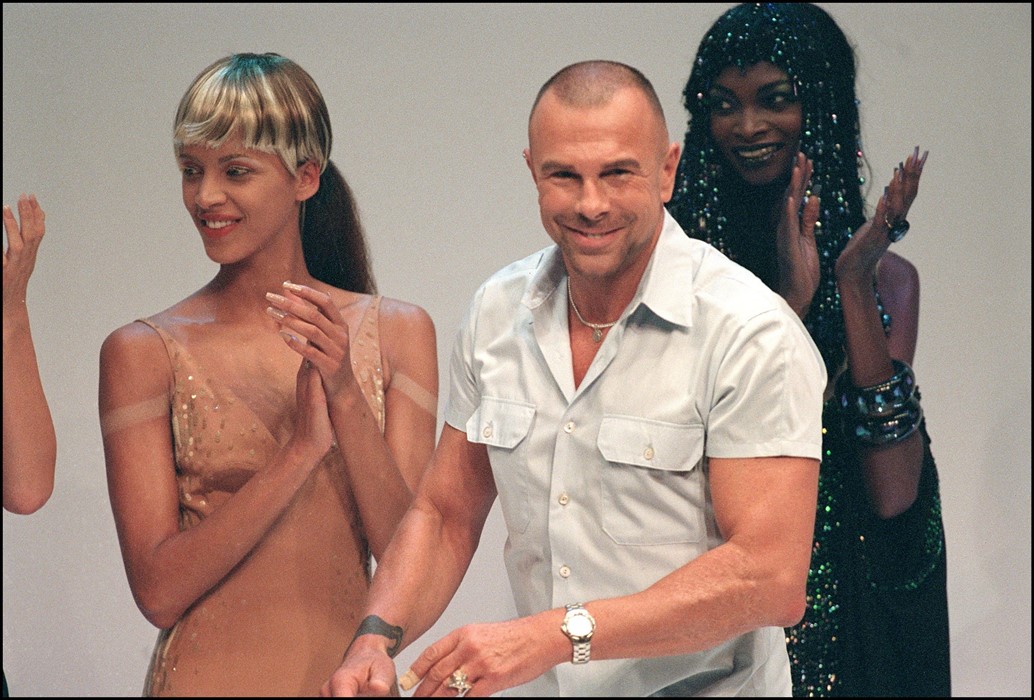From showmanship to S&M, celebrity to inclusivity, here are five ways that Mugler transformed fashion for good
Manfred Thierry Mugler – the French designer who defined the look of the 80s with his inverted triangle silhouette and radical fusion of fashion, pop culture and kink – has died at 73 years old. The specific cause of death is not yet known, although his agent has attributed it to “natural causes”.
Aside from the subversive catwalk shows for his eponymous brand, Mugler dressed countless celebrities in daring looks, from David Bowie in a pistachio green suit in 1991 to Kim Kardashian in a latex wet-look dress at the Met Gala in 2019. The impact of his designs still reverberates through fashion today, and our thoughts are with all who knew and loved him, as well as those who were touched by his work.
Casey Cadwallader, the current creative director of Mugler, wrote on Instagram about his predecessor’s progressive outlook. “Manfred, I am so honored to have known you and to work within your beautiful world. You changed our perception of beauty, of confidence, of representation and self empowerment. Your legacy is something I carry with me in everything I do. Thank you.”
From showmanship to S&M, celebrity to inclusivity, here are five ways that Mugler revolutionised fashion.
1. He put fashion and music together
Mugler understood that fashion felt most alive when paired with music; styling music videos and tours were a way to make his designs instantly iconic. During the decade of the supermodel, he directed a music video for George Michael’s 1992 song Too Funky where Linda Evangelista, Tyra Banks and more walked down a mock-runway in his decadent, futuristic designs. Over a decade later he was appointed artistic director for Beyoncé’s I Am... World Tour, dressing the American superstar in a bejewelled gold leotard (he wanted to portray her as both "a woman and a warrior"), while also contributing to elements like lighting, choreography and production.
2. He recognised the power of celebrity
Aside from helping sculpt the visual language of music by the likes of George Michael and Beyoncé, Mugler also dressed off-duty musicians and high profile celebrities for red carpet appearances. In 2019, Cardi B wore a resplendent Venus shell dress from 1995 to the Grammys, sparking a viral fashion moment while simultaneously reviving debates around wearing archive pieces on the red carpet. In the same year, he dressed Kim Kardashian in a nude, wet look latex dress dripping with crystals to the camp-themed Met Gala. The dress was inspired by Sophia Loren’s drenched look in the 1957 film Boy on a Dolphin, and reportedly took eight months to create – the look, like Kardashian herself, was highly divisive.
3. He fused S&M and high fashion
Much of Mugler’s oeuvre was influenced by the world of fetish gear; he often deployed restrictive sartorial accoutrements like latex and harnesses. Cindy Crawford and Naomi Campbell walked side by side in the Spring/Summer 1991 show wearing bondage bodysuits and nipple tassels, while at the Les Insectes Spring/Summer 1997 haute couture show, an army of women paraded down the runway dressed as ants in shiny black latex hats, sunglasses and gloved dresses. More recently, Kim Kardashian wore a vintage 1998 Mugler black dress with delicate cutouts that mimicked bondage harnesses and rope tied around the wrist.
4. He pioneered gender inclusivity on the catwalk
Mugler cast transgender models in his runway shows in the 1980s and made it his mission to collaborate with drag artists and other members of the LGBTQ community throughout his career. Mugler put New York drag legend Joey Arias in George Michael’s 1992 song Too Funky alongside some of the biggest supermodels of the time, and collaborated with corset maker Mr Pearl on some pieces. Casey Cadwallader is continuing this legacy of gender inclusivity at Mugler now, casting trans actors Hunter Schafer and Dominique Jackson in the Spring/Summer 2021 show, while previously working with trans models Raya Martigny and Kai-Isaiah Jamal.
5. For Mugler, fashion was fantasy
When Mugler created his eccentric, overblown designs in the 80s and 90s, minimalism was on the rise; in other words, he swam against the tides of fashion. His runway shows were pure spectacle, drawing varied inspiration from science fiction, vampires, devils, robots and the aquatic underworld. “I made clothes because I was looking for something that didn’t exist; I had to try to create my own world,” he once said.
